Post-war use of fighter aircraft created in Nazi Germany
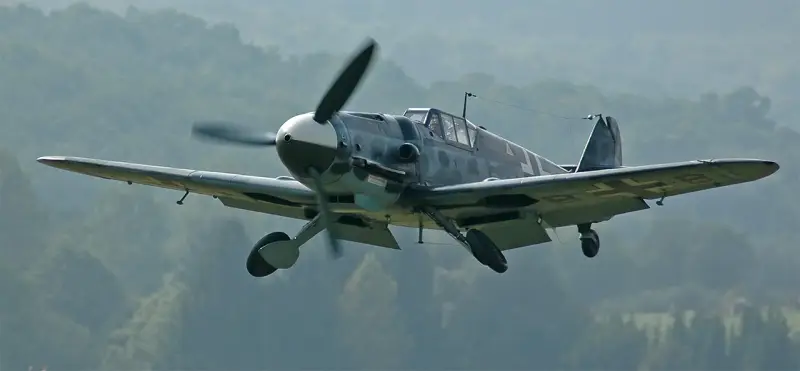
After the end of World War II, German-style fighters remained in service with the air forces of a number of states. Moreover, the serial construction of such aircraft continued, which even became a commodity on the global arms market. It is known that Czechoslovak-made fighters fought in the Middle East, and aircraft built in Spain were used in combat operations in Western Sahara.
In the USSR, USA, Great Britain and France, special groups were created to collect and deliver to these countries samples of aircraft created in the Third Reich. In addition to testing at training grounds, German fighters were used in flight schools to organize training air battles.
Focke-Wulf Fw190
One of the most successful German fighters of the second half of the war was the Fw 190, which also had the nickname “Würger” - “Shrike”.
The first prototype of the Fw 190V1, equipped with a BMW 139 engine, took off on June 1, 1939 and immediately demonstrated excellent handling, good visibility and a speed of over 600 km/h. Test pilots who flew the prototype also noted that its wide-set landing gear made it easier to take off and land, making it a safer aircraft compared to the Messerschmitt Bf 109.
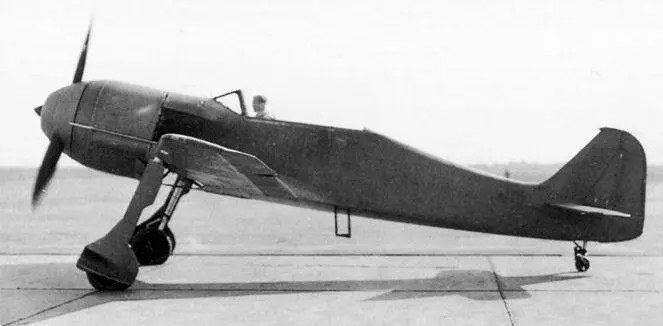
Fw 190 prototype
However, the Luftwaffe was not satisfied with the experimental aircraft, and it was returned for modification. The following shortcomings were identified: high stall speed (about 200 km/h), high temperature in the cabin, exhaust gases entering the cabin.
By the standards of the late 1930s and early 1940s, development of the fighter took quite a long time. Delivery of the Fw 190A-1 to combat squadrons began in the summer of 1941. During combat use, it turned out that the new German fighter was superior to the British Supermarine Spitfire Mk.V in all respects except horizontal maneuverability.
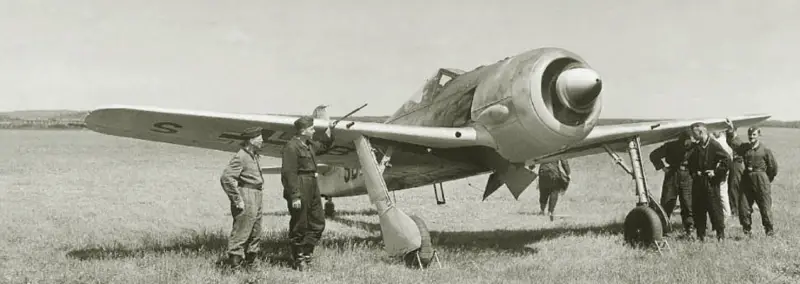
Of the first modifications, the Fw 190A-3 was the one that brought the most to an acceptable level of reliability, combat and service characteristics. The aircraft with a curb weight of 3855 kg was equipped with a 14-cylinder radial two-row air-cooled engine with direct fuel injection BMW 801D-2 with a take-off power of 1800 hp. With. The maximum flight speed at altitude was 610 km/h. When using short-term afterburner, the aircraft could accelerate in horizontal flight to 660 km/h. The cruising flight speed was 445 km/h. Practical range – 810 km. The service ceiling is 10 m. The armament for a single-seat fighter was very powerful: two 600-mm MG 20/151 cannons in the wing root with 20 rounds per barrel, two 200-mm MG FF cannons with 20 rounds per barrel and two 55. 7,92 mm MG 17 machine gun with 1000 rounds of ammunition per barrel in the front part of the fuselage.
Until the final collapse of the German war machine aviation The industry of the Third Reich managed to deliver about 20 Shrikes for various purposes. In addition to front-line fighters, high-altitude fighter-interceptors, fighter-bombers, attack aircraft, torpedo bombers and reconnaissance aircraft were produced.
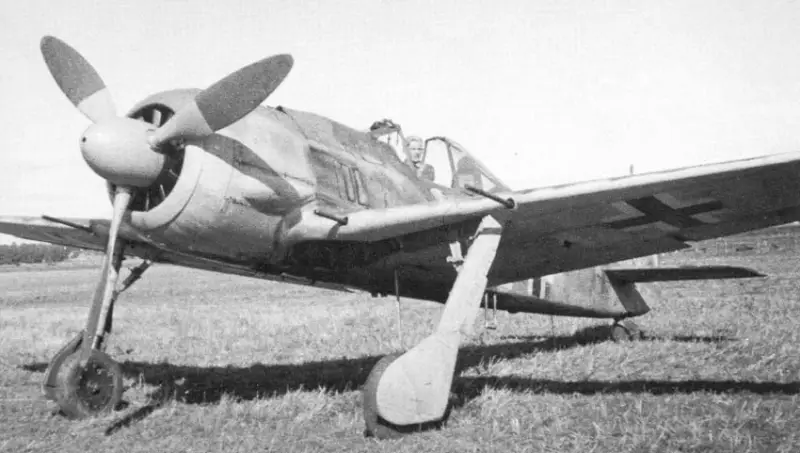
Fw 190A-8
The development of the line of high-altitude fighters was the Fw 190D "Dora", which was originally designed for the 12-cylinder liquid-cooled Junkers Jumo 213 engine, which was a further development of the Junkers Jumo 211. Compared to its predecessor, the Jumo 213 was smaller in size, developed higher speeds and had more power. But due to raids by British and American bombers, the deployment of mass production of this engine was greatly slowed down. It began to be produced in a relatively significant volume (300-500 pieces per month) only by mid-1944. At some stage, an attack version with a Jumo 213 engine was also designed, but due to a lack of resources, priority was given to the interceptor.
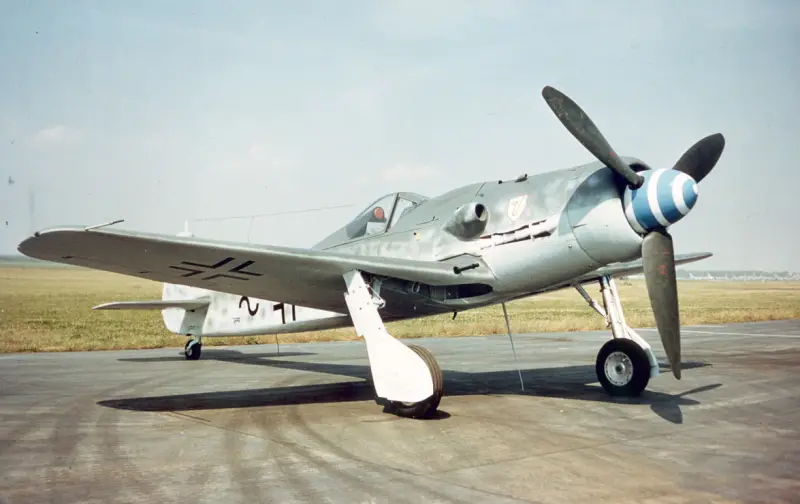
Fw 190D
The Fw 190D-9 modification fighter had a maximum take-off weight of 4840 kg. With the Jumo 213A-1 engine, which produced up to 1800 hp in afterburner. s., the plane at high altitude in horizontal flight could accelerate to 710 km/h. The service ceiling reached 12 m. The armament consisted of two 000-mm MG 20/151 cannons and two 20-mm MG 13,2 machine guns.
A further development of the Fw 190D was the Ta 152. This high-altitude interceptor was designed by Kurt Tank, produced by Focke-Wulf Flugzeugbau GmbH at the end of 1944 - beginning of 1945.
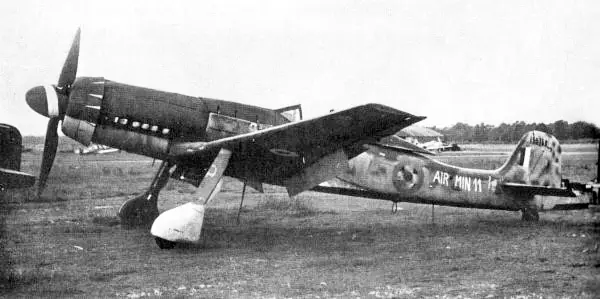
Ta 152H-1 captured by the British
The aircraft with a maximum take-off weight of 5217 kg was equipped with an inverted V-shaped 12-cylinder liquid-cooled Jumo 213E engine with a maximum power of 1750 hp. With. When using a boost system using the MW-5, a power of 2050 hp was achieved. With. At an altitude of 12 m with a supply of nitrous oxide, the Ta 500H-152 interceptor could accelerate to 1 km/h. The ceiling was 760 m. The practical flight range was up to 15 km. Armament: one 000-mm MK 2000 cannon with 30 rounds of ammunition and two 108-mm MG 90/20 cannons with 151 rounds of ammunition.
The Ta 152 interceptor had outstanding flight characteristics. But at the final stage of the war, the Germans were unable to organize mass production of aircraft of this type. A total of 49 prototypes were built along with the prototypes, which did not influence the course of hostilities.
During World War II, Germany supplied a relatively small number of FW 190 to foreign customers. Japan received one Fw 190A-5 and one Fw 190A-8 for testing. Hungary received 72 Fw 190F-8 attack aircraft. The Royal Romanian Air Force had 22 Fw 190A-8s, which they used to counter the bombing of oil fields and Romanian cities.
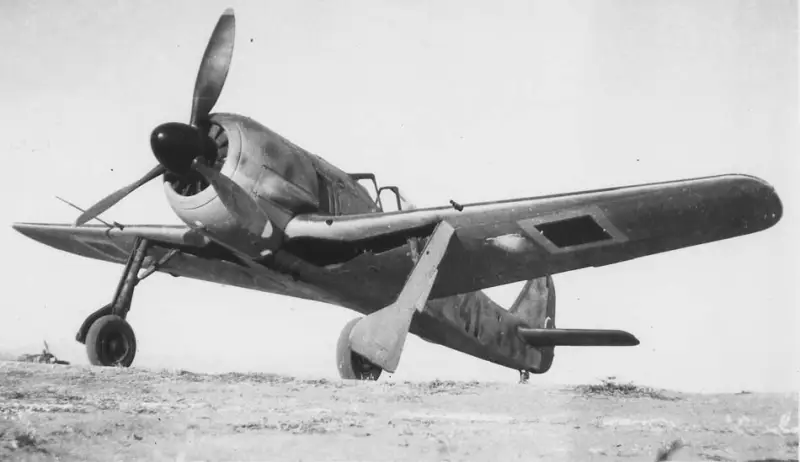
Turkish Fw 190A-3A
Türkiye received 1943 Fw 72A-190A by March 3. These export vehicles differed from German fighters mainly in the composition of their weapons. On Turkish aircraft, instead of the wing-mounted 20-mm MG 151/20 cannons, they returned to MG 17 rifle-caliber machine guns (a total of four 7,92-mm machine guns). At the same time, it was possible to hang containers with 20-mm MG FF/M cannons under the wings. Due to a shortage of spare parts, all Shrikes in Turkey were finally written off in 1949.
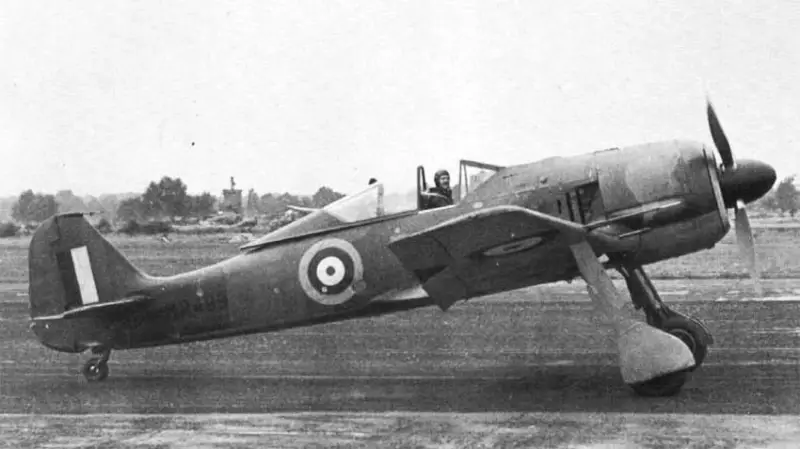
The British received the first Fw 190A-3, which landed at a British airfield due to a navigation error, on June 23, 1942.
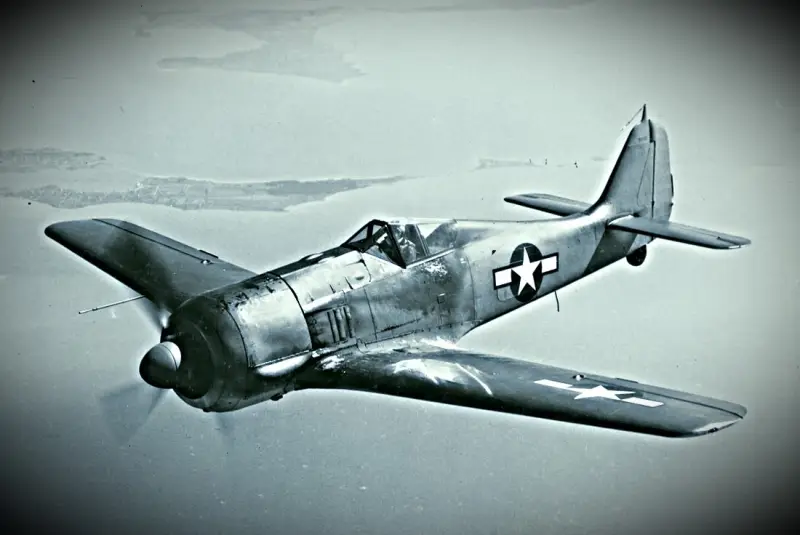
At the end of the war, the British and Americans had several dozen serviceable or repairable Fw 190 of various modifications at their disposal. Some of them flew until 1947.
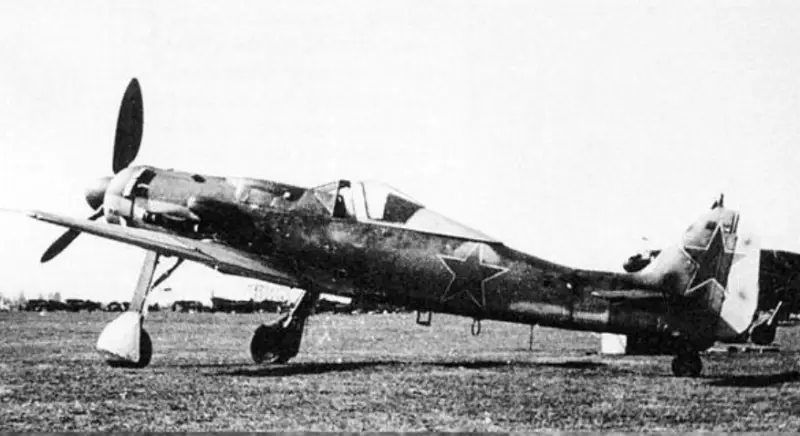
Several Fw 190s were part of the Baltic aviation in the post-war period. fleet. It is known that the Fw 190D was also used by the Red Army Air Force to organize training battles during advanced training courses for flight personnel.
English-language sources say that the French assembled 70 aircraft of the Fw 190A-5/A-6 modifications from components abandoned by the Germans during the retreat at an aircraft repair plant located in the underground galleries of Cravant.
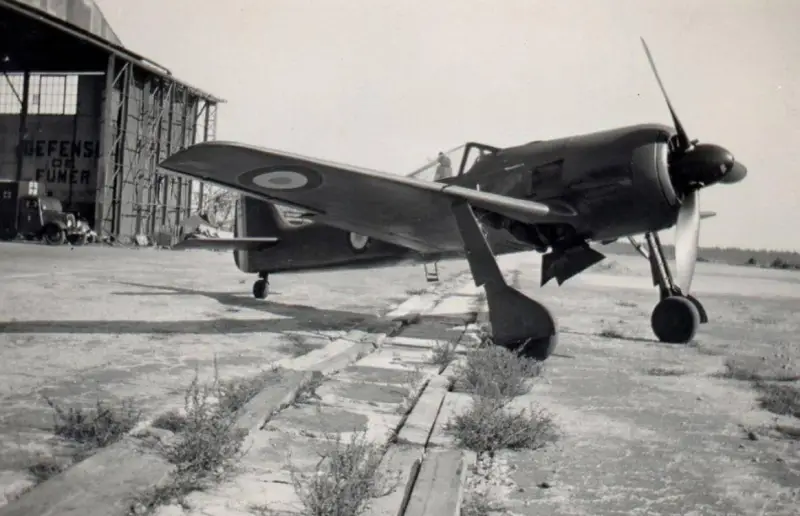
SNCAC NC.900
This fighter was adopted by the French Air Force under the designation SNCAC NC.900. The aircraft were mainly supplied to training units. The only combat unit that received “Franco-German” fighters was the Normandy-Niemen air regiment. However, due to operational problems with the BMW 801D-2 engines and poor manufacturing quality of critical parts, the SNCAC NC.900 aircraft were taken out of service in November 1946.
Heinkel He 112
Nowadays, few people remember about this fighter, which at some stage was a competitor to the Messerschmitt Bf 109. The appearance of the He 112, as well as the He 111 bomber described in the previous publication, was largely due to the success of the single-engine He 70 Blitz.
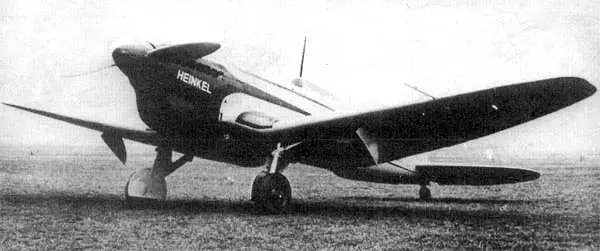
He 112V1
The He 112V1 prototype, which took off on September 1, 1935, was strongly reminiscent of the reduced He 70 in its outline. The first prototype had a 12-cylinder V-shaped British Rolls-Royce Kestrel engine with a power of 695 hp. s., and the second copy was equipped with a German 640-horsepower Junkers Jumo 210 engine.
Testing of experimental He 112s as part of the competition for a new Luftwaffe fighter was carried out in parallel with the Bf 109, and at first the military and representatives of the Ministry of Aviation could not clearly give preference to one of the competitors. Chance intervened: during test flights, two accidents occurred with the He 112 in a short time, and the aircraft of Bayerische Flugzeugwerke AG gained an advantage. It was also partly due to the fact that the Heinkel Flugzeugwerke concern was sufficiently loaded with orders, and the He 112 fighter was not a priority aircraft.
As a result, the Bf 109, having completed the entire test cycle without any problems, took the lead and was officially put into service in the summer of 1936. An important factor was that the aircraft designed by Willy Messerschmitt was cheaper and easier to maintain.
Nevertheless story Not 112 didn't end there. In case of failure of the Bf 109 at the stage of military testing, Heinkel was assigned a contract for a small series of 15 fighters. These aircraft, in fact, were also experimental; they differed in engine types, cabin shape and weapons. Two vehicles from this series were sent to Spain as part of the Condor Legion, where they performed well thanks to their powerful weapons. On one aircraft in 1937, an additionally installed liquid-propellant rocket engine was tested, running on methanol and liquid oxygen.
Simultaneously with the tests, there was an active advertising campaign for the fighter in the German media. Although the Luftwaffe eventually abandoned the He 112, foreign buyers became interested in it. From 1935 to 1939, a total of 98 He 112s were built, including 15 prototypes.
At the end of 1937, Japan decided to purchase 30 He 112B fighters, which were planned to be used to provide air defense to naval bases. Although several aircraft survived until September 1945, there is no information about their use in combat.
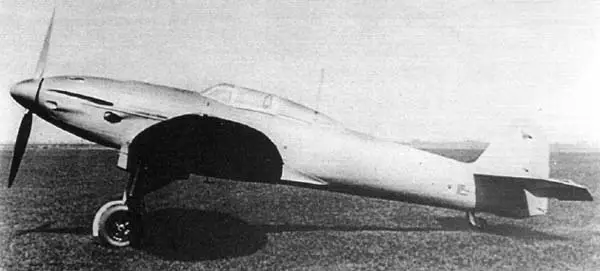
Not 112V
Not 112B was a single-seat, single-engine, all-metal cantilever monoplane with a lower wing, retractable landing gear and an enclosed cockpit. The plane had a normal take-off weight of 2250 kg. Liquid-cooled engine Junkers Jumo 210E with 680 hp. With. provided a maximum speed of 510 km/h. Cruising speed – 480 km/h. Practical ceiling – 8300 m. Practical flight range – 1100 km. For that time, the fighter had strong small arms and cannon armament: two 20-mm MG FF cannons and two 7,92-mm MG 17 machine guns.
In 1938, four He 112Bs were purchased by Hungary. Plans for organizing licensed production in this country were also considered. However, the Hungarians did not accept the fighter; one plane crashed shortly after arriving in the country, and the rest were written off in 1944.
The only country that actively used the He 112B in combat was Romania, which bought three dozen vehicles in 1939.
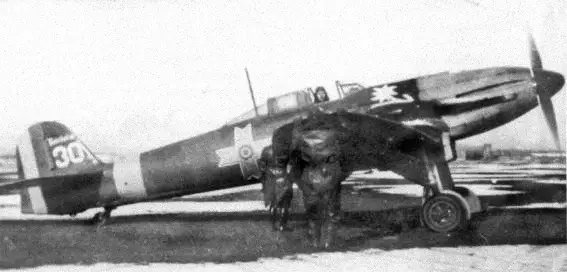
He 112B of the Romanian Air Force
Fighters of this type fought quite actively in 1941 in the offensive zone of the Romanian troops on the Eastern Front. In 1942-1943. They tried to use the He 112B in the role of night fighters against Soviet bombers attacking Constanta, Bucharest and Ploesti. In the summer of 1943, the Romanian He 112B was transferred to the training category; the last aircraft was written off in 1947.
In 1939, Francoist Spain received 19 fighters of the B1 and B2 modifications, differing in engine brand. The He 112B1 had a carburetor Jumo 210E, and the He 112B-2 had a Jumo 210G with direct fuel injection into the cylinders.
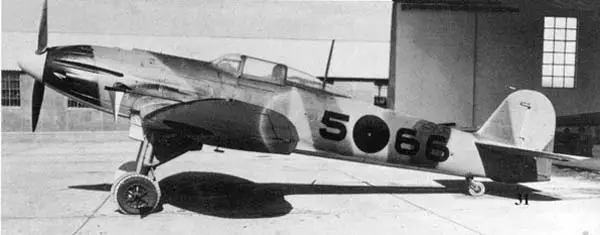
Spanish Air Force He 112B1
During wartime, Spanish Air Force fighters did not participate in combat operations; they suffered losses due to equipment failure, bad weather conditions and pilot errors. In 1947, eight He 112B remained in flight condition. The last two Heinkels were taken out of service in 1952.
Messerschmitt Bf.109
From the very beginning of World War II until the surrender of Nazi Germany, one of the main combat aircraft of the Luftwaffe was the Bf.109. Since the fighter project was presented by Bayerische Flugzeugwerke, in all official German documents the prefix “Bf” was used in the designation of the aircraft.
As mentioned above, this very successful aircraft, which had many modifications, was ahead of the He 112 in the competition announced by the Ministry of Aviation, which envisaged the creation of a monoplane fighter that was supposed to replace the outdated He 51 and Ar 68 biplanes. During the creation of the Bf .109 actively used the developments obtained in the process of designing and introducing into production the Bf 108 Taifun sports aircraft.
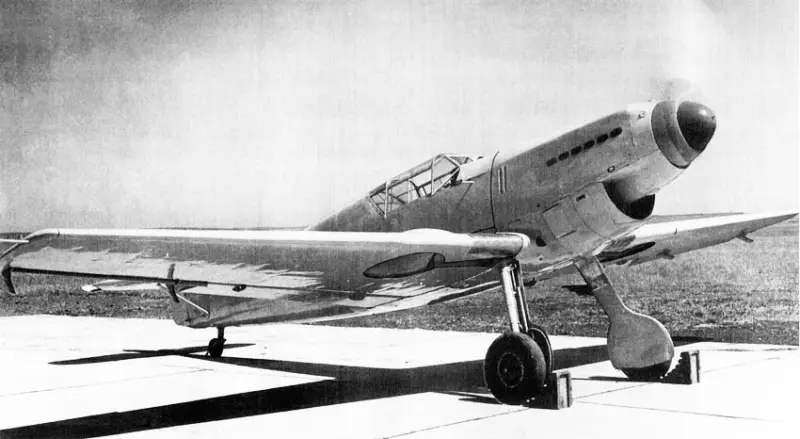
Bf 109V1
Experienced Bf 109V1 with a British Rolls-Royce Kestrel VI engine producing 695 hp. With. made its first flight on May 28, 1935. The second prototype of the Bf.109V2, already with the German Jumo 210A engine, was launched for testing in January 1936.
The first production version was the Bf 109B with a Jumo 210Da engine that produced power up to 720 hp. With. This aircraft with a normal take-off weight of 2150 kg had a practical flight range of 690 km. In horizontal flight at an altitude of 4500 m, it could accelerate to 460 km/h. Cruising speed was 350 km/h. Ceiling - 8200 m. Armament was limited to two 7,92 mm MG 17 machine guns under the engine hood.
The next modification of the Bf 109C was equipped with a more powerful Jumo 210Ga engine with a direct fuel injection system, which made it possible to slightly increase the maximum speed and flight altitude. The armament was reinforced: two MG 17s were located above the engine (500 rounds per barrel), and one at the base of the wing consoles (420 rounds per barrel).
The Bf 109C's baptism of fire took place in Spain, where it received a generally positive assessment. At the same time, the aircraft of the Bf 109B/C modifications were very crude, they lacked engine power, and “childhood sores” constantly appeared.
The Bf 109E became truly popular with the new Daimler-Benz DB 601 engine (takeoff power 1050 hp) with a direct fuel injection system and a fluid coupling in the supercharger drive. The maximum flight speed reached 548 km/h. This modification entered service with the troops in 1939.
The first Emils had the same armament as the Bf 109C. However, already during air battles in Spain, it became clear that rifle-caliber machine guns often could not guarantee reliable destruction of the target, and large-caliber machine guns and automatic cannons began to be installed on fighters.
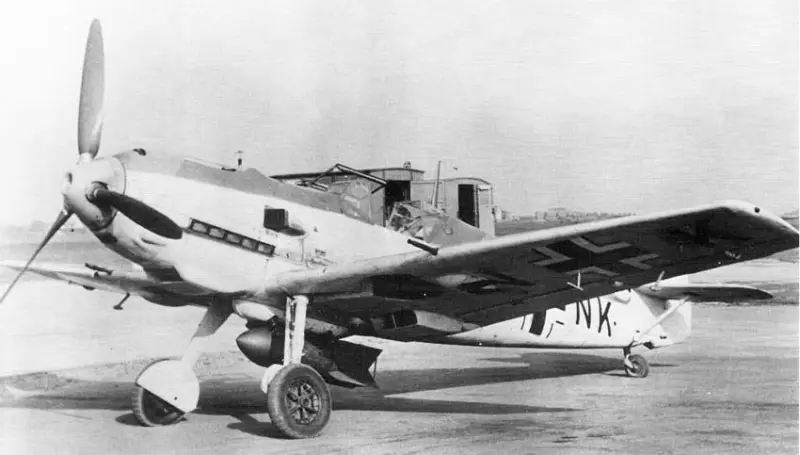
Bf 109E-3 with 250 kg bomb
The Bf 109E-3 fighter had two wing-mounted 20-mm MG FF cannons (ammunition capacity - 60 rounds per barrel), firing outside the propeller disk, and two synchronized 7,92-mm MG 17 machine guns with 1000 rounds per barrel, mounted on a motor mount above the engine . The aircraft could also carry 50-250 kg aerial bombs and was often used as a fighter-bomber. To increase resistance to fire, 58 mm thick armored glass was installed on the attack vehicles, protecting the pilot from the front. A 6-mm steel armor plate was mounted behind the tank, covering the entire cross-section of the fuselage.
In subsequent versions of the Bf 109, engine power was consistently increased, weapons and service characteristics were improved.
The Bf 109G, which entered service in May 1942 and is the most popular in the Bf 109 family, received a new Daimler-Benz DB 605 engine, based on the DB 601. The DB 605 cylinder block was redesigned in such a way that the volume increased from 33,9 up to 35,7 liters gave an increase in power by 175 horsepower with almost the same engine dimensions.
The Bf 109G-6 modification fighter was created as a universal weapons carrier, making it possible in the field to quickly change the aircraft’s equipment depending on the situation and combat missions. The armored backrest behind the pilot's seat had a transparent armored glass headrest, which significantly improved visibility. In the most widespread version, the aircraft carried a 20-mm MG 151/20 cannon in the cylinder block and two 13,2-mm MG 131 machine guns above the engine. It was also possible to hang a wide variety of weapons under the wing: containers with cannons and machine guns, rockets and bombs.
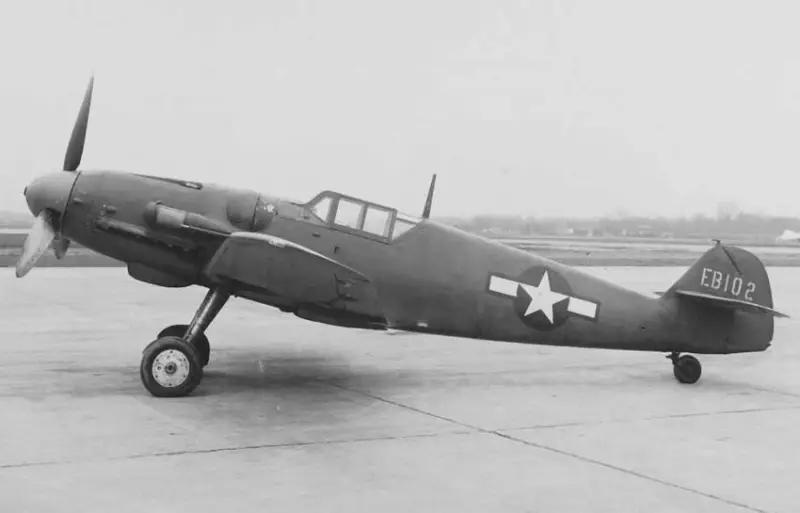
Bf 109G-6 captured by the Americans
Bf 109G-6, equipped with a Daimler-Benz DB 605AM engine with a power of 1475 hp. s., in horizontal flight at an altitude of 8700 m could accelerate to 620 km/h. The maximum take-off weight reached 3400 kg. Practical flight range without an additional tank is 560 km, with an additional tank – 990 km. Service ceiling – 11 m.
The last production version was the Bf 109K with a Daimler Benz 605ASCM engine with the MW 50 boost system, which increased power to 2000 hp. With. At an altitude of 8700 m, the aircraft could reach a speed of 695 km/h or 720 km/h at 6000 m. With a maximum take-off weight of 3400 kg, the flight range was 580 km. Ceiling – 12 m.
The Elector, mass-produced from the second half of 1944, had very powerful, but at the same time balanced weapons. The fighter of this modification received a 30-mm MK-108 cannon with a 60-round belt. A hit from one 30-mm high-explosive projectile of increased power, weighing 330 g (explosive charge mass 85 g), was enough to destroy a single-engine all-metal fighter. In addition to the 30 mm cannon were two 13,2 mm MG 131 machine guns. Some aircraft were armed with three 20 mm MG 151/20 cannons. Options with wing-mounted 30-mm cannons were also tested.
Bf 109 fighters were built en masse at many enterprises and were often redesigned in factories and in front-line workshops. According to American data, from September 1, 1939 to May 2, 1945, production amounted to 30 units. In the pre-war period, from 573 to August 1936, 1939 copies were built, including prototypes.
Messerschmitts of various modifications were actively exported and in a number of countries were built under license or assembled in the post-war period from components inherited from the Germans.
During World War II, Bulgaria received 19 Bf 109Es, as well as more than a hundred fighters of the G-2, G-6 and G-10 modifications. After Bulgaria declared war on the Third Reich and its allies on September 10, 1944, Bulgarian fighters, which received new identification marks, began to attack German aircraft. After the end of World War II, the Bf 109Gs that survived the battles served for about another year, after which they were replaced by Soviet-made aircraft. Some of the fighters that retained sufficient operational life were sold to Yugoslavia.
Between 1942 and 1944, 2 Bf 109Ds, 40 Bf 109Es, 66 Bf 109Fs and 260 Bf 109Gs were delivered to Hungary. Another 537 fighters were built under license, which were divided between the Hungarian Air Force (227 units) and the Luftwaffe.
The Royal Hellenic Air Force took into service several Bf 109G-6s left behind during the German retreat in October 1944.
In 1943, the Italian Air Force was reinforced with several dozen Bf 109G-6/G-10/G-14. After the country emerged from the war, some of the aircraft were destroyed or captured by the Germans. But about two dozen fighters survived, and they flew in the post-war period.
According to reference data, the Germans transferred about fifty Bf 109E/F and about two hundred Bf 109G to Romania. 124 Bf 109Gs were assembled at the IAR facility in Brasov.
The Slovak Air Force operated 16 Bf 109Es and 30 Bf 109Gs. All of them were lost during the Slovak National Uprising in 1944.
In 1944, the Croatian Air Force had 21 Bf 109Gs. By March 1945, losses amounted to 15 units. However, additional supplies of aircraft made it possible to maintain the size of the fighter fleet at a constant level. The last delivery of fighters took place on April 23, 1945, when the defeat of Germany itself was already inevitable. Several Croatian Messerschmitts, captured by partisans, subsequently became part of the SFRY Air Force. In 1946, Yugoslavia purchased Bf 109G fighters from Bulgaria. Yugoslav Bf 109 modifications G-2, G-6, G-10 and G-12 were assembled in the 172nd IAP and operated until 1954.
In 1943, Bf 109 fighters appeared in the Finnish Air Force. In total, the Finns were sent: 48 Bf 109G-2, 109 Bf 109G-6 and 2 Bf 109G-8.
When talking about the Finnish Messers, one cannot help but mention that in Finland an attempt was made to copy a German fighter. However, the Finnish car cannot be called a complete analogue of the Bf 109G. Since there was no duralumin in Finland, they decided to build the aircraft using the technology used to create their own Myrsky II fighter. The power plant was the German Daimler-Benz DB 605. However, after the construction of the prototype, it became clear that the aircraft was too heavy and, according to flight data, was much inferior to the Bf 109G.
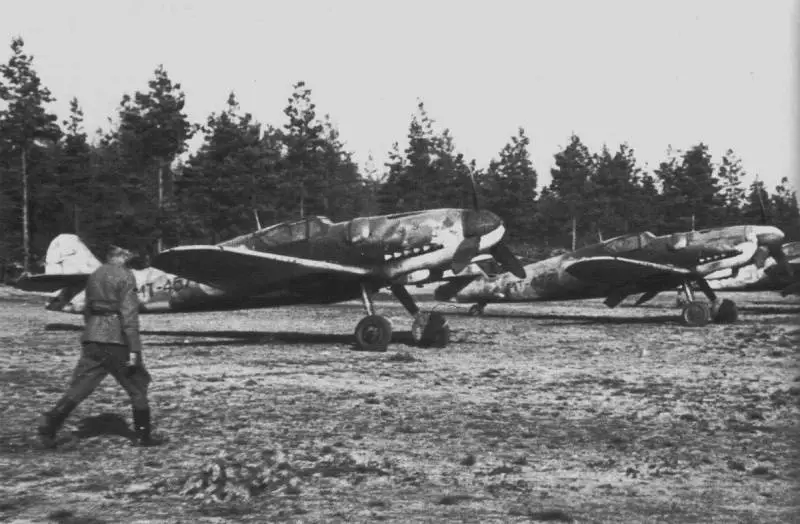
Finnish Air Force Bf 109G-6 fighters parked at Utti airfield
After leaving the war in September 1944, the Finns had to remove the German Ostfront tactical markings: the yellow engine cowlings and undersides of the wingtips, the yellow rear fuselage stripe and the Finnish swastika. They were replaced by emblems of the colors of the Finnish flag.
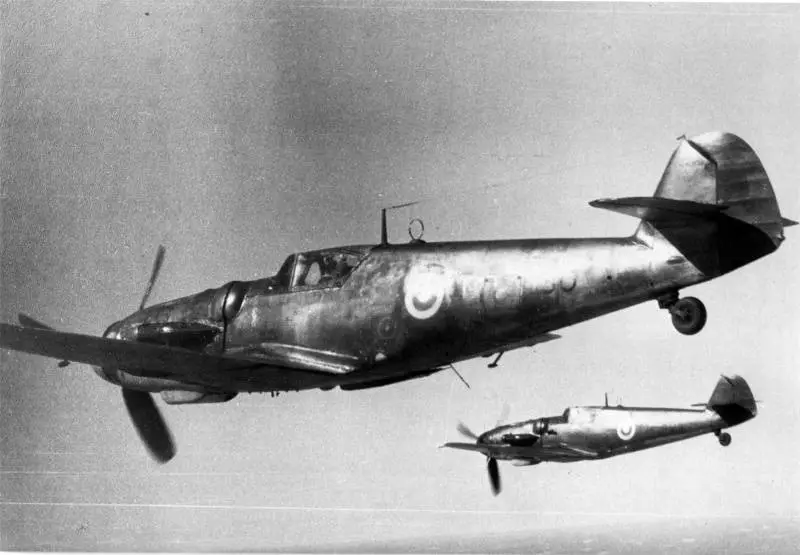
Bf 109G fighters served in the Finnish Air Force until 1954, until the airframe's service life was exhausted and deliveries of jet aircraft from abroad began.
Before the start of World War II, Switzerland acquired 90 fighters of the Bf 109D and Bf 109E modifications. These fighters carried four 7,5 mm machine guns. Eight more Bf 109Es were assembled locally from German components. The Swiss Doras and Emilys flew until 1949.
In 1944, in exchange for permission to destroy a German Bf 110G fighter with secret equipment that made an emergency landing in Switzerland, Germany sold 12 more Bf 109G-6s. As it turned out later, all twelve aircraft had many manufacturing defects. Among those included in the combat strength of the Swiss Air Force were two Bf 109G and two Bf 109F, which made unauthorized landings in the country. All Bf 109G and Bf 109F were written off by 1948 due to operational problems.
A number of sources say that in 1941 Japan bought from 2 to 5 aircraft of the Bf 109E-7 modification, which were tested in training battles with Nakajima Ki-43 Hayabusa, Nakajima Ki-44 Shoki and Kawasaki Ki-61 Hien fighters. Since Japan produced the Kawasaki Ki-61 Hien with a Kawasaki Ha 40 engine (Daimler-Benz's own version of the DB 601A), the German fighter, which had similar characteristics to the Ki-61, was not of interest to the Japanese military.
Of greatest interest is the history of the post-war use of Czech and Spanish fighters, and these will be examined in more detail.
Due to intense bombing of German aircraft factories located in Germany, at the end of the war an attempt was made to assemble the Bf 109G fighter aircraft at the Avia plant in Prague-Cakowice. After the restoration of Czechoslovakia's independence, a significant number of components remained, and the production of German-style fighters continued. The single-seat Bf-109G-14 was designated S-99, and the two-seat Bf-109G-12 trainer was designated CS-99.
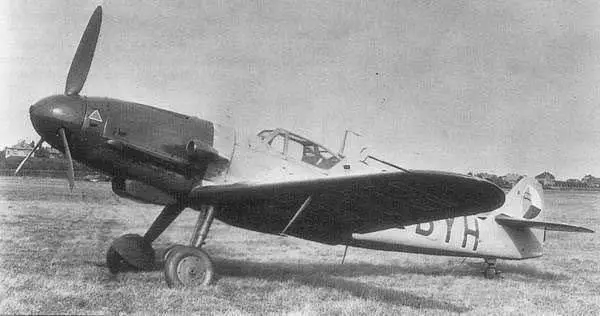
series
But fighter production volumes were limited by a shortage of Daimler-Benz DB 605 engines, and by 1947 only 20 S-99 and 2 CS-99 were built. Czechoslovak designers proposed to solve the problem by installing on the Bf 109 other German aircraft engines available in the country - the Junkers Jumo-211F with a power of 1350 hp. With. An aircraft with such an engine was designated Avia S-199.
In addition to the new engine, the S-199 fighter used a metal propeller of increased diameter, a different hood and a number of auxiliary units. The composition of the armament also changed: instead of a 20-mm MG 151/20 motor cannon and a pair of 13,2-mm MG 131 machine guns, the S-199 retained two synchronized heavy-caliber MG 131 machine guns; two more 7,92-mm machine guns could also be mounted in the wing. mm machine gun, or two 20-mm MG-151/20 cannons were suspended in special gondolas.
The Junkers Jumo-211F engine was originally created for bombers and had a longer service life, but at the same time it was significantly heavier and produced less power. As a result, the S-199 was noticeably inferior in flight performance to the Bf-109G-14. The speed in horizontal flight dropped from 630 km/h to 540 km/h, the ceiling - from 11 m to 000 m. In addition, the heavy engine caused a sharp forward shift of the center of gravity, and this significantly complicated piloting, especially during takeoff and landing. Nevertheless, S-9000 fighters were mass-produced until 199, and more than 1949 aircraft were assembled. Despite the relatively poor performance of its German prototype, the S-500 was in service with the Czechoslovak Air Force until the mid-199s.
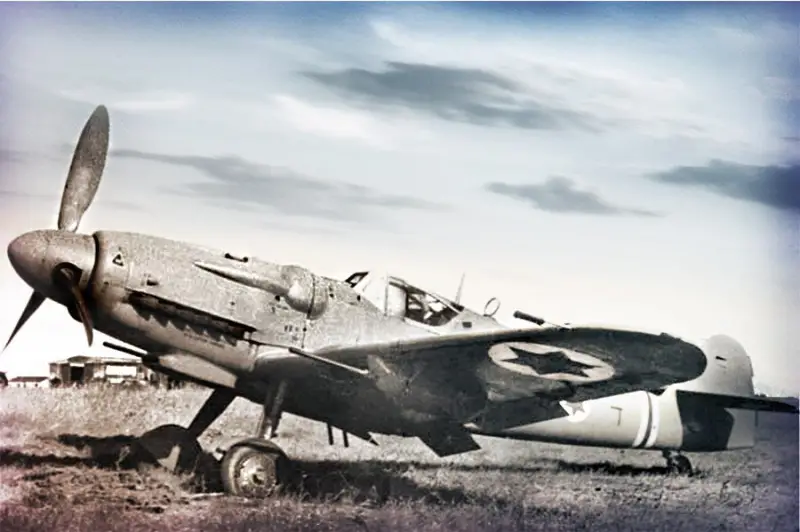
In April 1949, 25 S-199s were sold to Israel. These fighters took part in air battles, and their pilots claimed eight Arab aircraft were shot down.
It is noteworthy that Spain, the first to receive Messerschmitts, also operated them the longest. A significant part of the Bf 109C fighters that were in service with the German Condor Legion subsequently joined the Spanish Air Force. In 1939, new additions arrived in the form of the Bf 109E. In total, out of 136 Bf 109s sent to help the Francoists, Spain received 47 Bf 109C/E/D. To strengthen the air defense and armament of the Spanish volunteer squadrons fighting on the Eastern Front, Germany also transferred fighters of the F and G modifications.
In 1942, the Spanish government agreed to acquire a license for the production of the Bf 109G-2. As part of the intergovernmental agreement, the propeller group, instruments, radio stations and weapons were to be supplied from Germany. However, these plans failed to be realized. Due to the fact that the Luftwaffe was in dire need of combat aircraft, the Germans were only able to supply 25 gliders, and as a result, Hispano Aviación had to build the aircraft themselves.
The prototype, designated HA-1109-J1L, was powered by a Hispano-Suiza 89-12Z engine producing 1300 hp. With. made its first flight on March 2, 1945. All completed aircraft with Spanish engines were handed over to the customer at the beginning of 1947, but due to numerous shortcomings, these aircraft were never used as full-fledged fighters.
An improved model HA-1112-K1L with a Hispano-Suiza engine - HS 17-12Z, armed with two 20 mm cannons and sixteen 80 mm rockets, went into production in May 1951.
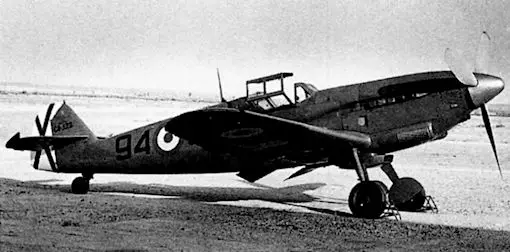
Soon after the HA-1112-K1L began to enter operational squadrons, it became clear that the combat potential of these aircraft was low. To improve flight performance, a batch of Rolls-Royce Merlin 500-45 engines with a power of 1600 hp was purchased in the UK. With. Of the 239 Messers built in Spain, 170 were equipped with Rolls-Royce engines.
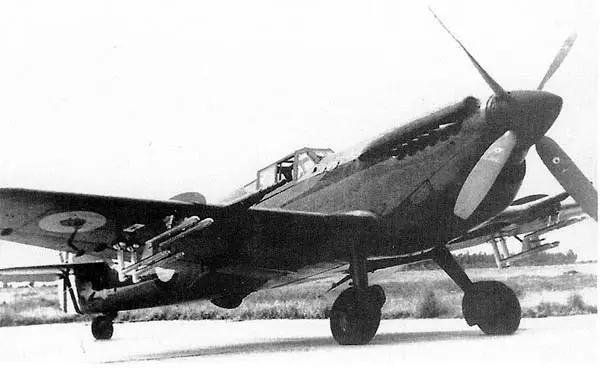
First production HA-1112-M1L
The aircraft with an English engine received the designation HA-1112-M1L (military name S.4K Buchón). The maximum take-off weight was 3200 kg. Maximum speed – 665 km/h. Cruising - 400 km/h. Practical range – 765 km. Service ceiling - 9800 m. Armament: two 20-mm Hispano-Suiza HS.404/408 cannons and 16 80-mm Oerlikon missiles.
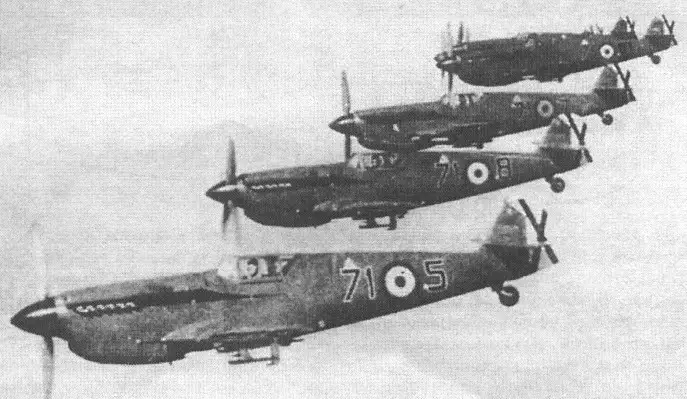
As a full-fledged fighter, the HA-1112-M1L was hopelessly outdated in the mid-1950s, but as an attack aircraft it was quite capable. In 1958, fighter-bombers of the 71st Air Group took part in the fighting in the Spanish colonial possessions in the Sahara, striking rebel positions and tracking down convoys delivering weapon and supplies.
Operation of the Spanish-built Messerschmitts officially ended in December 1965. However, 17 reanimated aircraft were transported to England in 1967, where they took part in the historical film “The Battle of Britain,” which required a large number of German aircraft from World War II. Subsequently, several S.4K Buchóns ended up in the collections of aviation museums and private aviation enthusiasts.
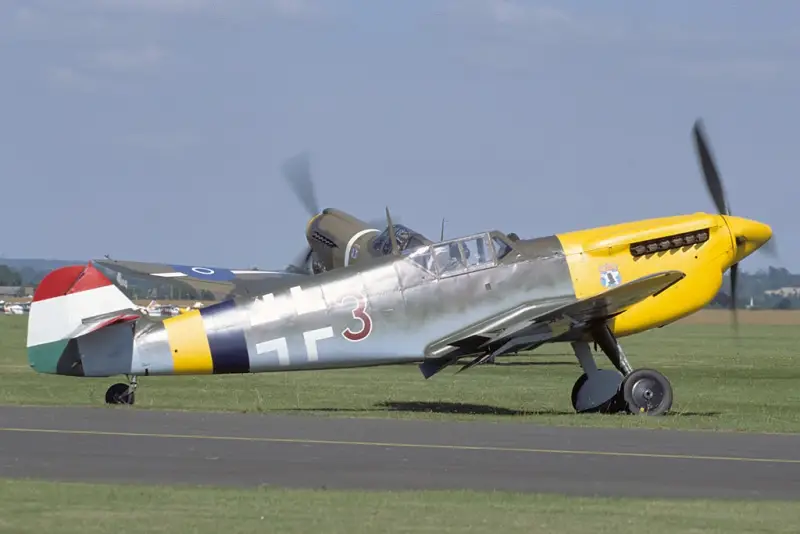
Currently, in the USA and European countries there are more than a dozen live Messerschmitts that regularly take part in air shows held in different countries. These are primarily restored Spanish HA-1112-M1L, as well as restored German Bf 109E and G.
Продолжение следует ...
Information